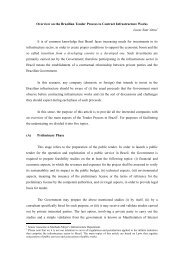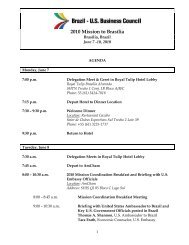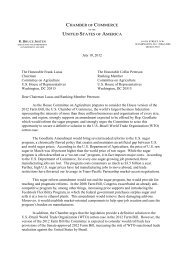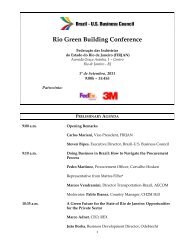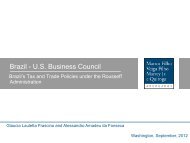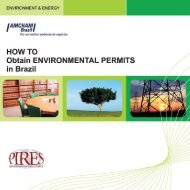Questions for Brazil ethanol industry feature - Brazil-US Business ...
Questions for Brazil ethanol industry feature - Brazil-US Business ...
Questions for Brazil ethanol industry feature - Brazil-US Business ...
Create successful ePaper yourself
Turn your PDF publications into a flip-book with our unique Google optimized e-Paper software.
consumption <strong>for</strong> use as fuel is estimated at 22.5 billion liters <strong>for</strong> 2012. Ethanol consumption <strong>for</strong>other uses is projected at 2.55 billion liters, up 200 million from 2011 due to steady demand fromthe chemical industries.The size of the <strong>Brazil</strong>ian light vehicle fleet is roughly estimated at 28 million units and purehydrous <strong>ethanol</strong> and flex fuel powered vehicles represent together approximately 50 percent ofthe total fleet. Industry projections report that the share of flex fuel vehicles is likely to reach 86percent by 2020.The use of <strong>ethanol</strong> as a fuel in <strong>Brazil</strong> reached 19.1 million cubic meters in 2011. <strong>Brazil</strong>iangasoline contains between 20 and 25% of <strong>ethanol</strong>.BIC: What are the latest technological advances in <strong>ethanol</strong> production?SERAFIM: In addition to actions aimed at a strong dissemination of technologies that arealready commercially available, innovation in <strong>ethanol</strong> production processes and productdiversification (from sucrose and lignocellulosic sugar-cane waste) are going to take place.New technologies <strong>for</strong> <strong>ethanol</strong> production are under development such as: improvement ofprocesses <strong>for</strong> water saving, increase in <strong>ethanol</strong> production efficiency, improvement of processes<strong>for</strong> energy cogeneration, development of new processes based on <strong>ethanol</strong> chemistry andsugarcane biomass development, improvement of motors and turbines <strong>for</strong> maximization of energyefficiency in the use carburant <strong>ethanol</strong>.The genetic modification of sugarcane is advancing very fast in <strong>Brazil</strong> both on an experimentalscale and in field-testing. For example, the sugarcane genome was originally mapped in 2001 inSao Paulo, and dozens of projects that also address functional genomes are being developed byboth public and private institutions.Product diversification is being expanded to include sucrose products and <strong>ethanol</strong> chemistry, as isan increase in energy production from the sugarcane biomass. Excluding sucrose, the energycontained in one metric ton of sugarcane (including the straw) is equivalent to 2/3 of the energycontained in an oil barrel. That biomass can be recovered at relatively low costs, and less thanhalf of it is used today. Available technologies can generate additional electric powercorresponding to 30 percent more than the sugar and <strong>ethanol</strong> sale price using the bagasse and 50percent of the straw. The development of an efficient conversion of biomass into <strong>ethanol</strong>(expected <strong>for</strong> the next 10 years) could lead to an equal additional sale value.BIC: What are the prospects <strong>for</strong> cooperation between the United States and <strong>Brazil</strong>with regard to <strong>ethanol</strong>?SERAFIM: The United States and <strong>Brazil</strong> have signed a Memorandum of Understanding onbiofuel cooperation. The two nations pledged closer cooperation on researching alternativeenergy production, promoting alternative fuels in the region and developing <strong>industry</strong> widestandards and codes that could lay the groundwork <strong>for</strong> a global biofuels market. Steps are alreadybeing taken to cooperate on harmonization of <strong>ethanol</strong> markets, trans<strong>for</strong>ming the biofuel into acommodity and developing partnerships in technology.



